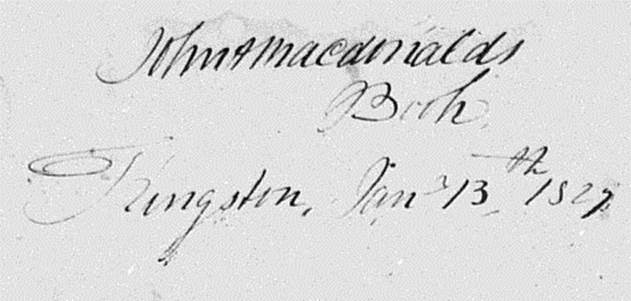Introduction

John A. Macdonald’s mathematics school notebook was written by him in 1827 when he was 12. The notebook is in the genre of cyphering books that have been analyzed by Nerida F. Ellerton and M.A. (Ken) Clements in two monographs: Rewriting the History of School Mathematics in North America 1607 – 1861: The Central Role of Cyphering Books and Abraham Lincoln’s Cyphering Book and Ten other Extraordinary Cyphering Books. Typically, at this time all students aged 10 or more across Europe and North America prepared these cyphering books as a method of learning their mathematics.
The general format for a cyphering book would be to have a set of sequenced topics in which each topic has a set of rules followed by cases, model examples, and exercises. The most common type of cyphering book deals with commercial arithmetic beginning with basic arithmetical manipulations. John A’s notebook does not contain any commercial arithmetic. His cyphering book begins with general properties of numbers and then proceeds to deal with the arithmetic of vulgar fractions. It culminates with topics in square and cube roots with applications of Pythagoras’s Theorem to calculating the side of a right-angled triangle. Macdonald must have learned basic arithmetic prior to writing his notebook.
There was a general procedure that was followed to produce a cyphering book; and Macdonald’s notebook is probably no exception. The teacher would cover a topic in class. The student would memorize the rule described in class and demonstrate knowledge by reciting the rule. Then the student would solve set problems either on a slate or on scraps of paper. Once corrected, the student was then expected to write out the topic, rules and problems in a fine hand in the notebook. The fine copy was shown to the teacher at which time the student progressed to the next topic.
John A’s notebook indicates a bit of lack of interest setting in in this particular set of mathematical exercises. He makes a few minor arithmetical and copying errors deep in the notebook. He also quits the notebook mid topic. The final topic is cube roots. Macdonald defines a cube root and then has a heading for the next topic “Application and use of the cube root”. What follows has nothing to do with cube roots and it was written at least three years after the mathematical entries in the notebook were completed. The material that replaces what should be cube root calculations is actually part of a ghost story. The excerpt from the story that John A copied is a political description of King Charles XI of Sweden including how the king “changed the entire constitution of his country,” a foreshadowing of what Macdonald did himself 30 to 40 years later. Macdonald was apparently just using handy empty pages of his old notebook. In a later entry in the notebook, Macdonald has copied the words to the song “Go Where Glory Waits Thee” by the Irish poet Thomas Moore, best known for the lyrics to “The Minstrel Boy” and “The Last Rose of Summer”.


